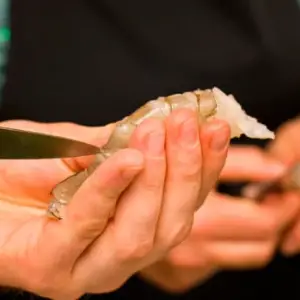Shrimp ranks high amongst a myriad of seafood ingredients when it comes to versatility, and while this is a cemented fact, one thing, when it comes to shrimp preparation is likely disputed, deveining.
To devein or not to devein, and if so, should one devein both sides or only one side?
That’s a very popular question in the heads of many seafood lovers out there, and in this article, we’ll explore the world of shrimp anatomy and find out the dos, don’ts, what’s and why’s of deveining.

Is There A Vein On Both Sides Of Shrimp?
Indeed, there are veins (or more accurately, vein-like structures) on both sides of shrimp; however, they are not quite the same.
On the top side (curved side) of a shrimp, you’ll find the dark “vein” also known as “sand vein” which is actually the shrimp’s digestive tract.
This is the most commonly removed “vein” on a shrimp as it may contain residual waste, which some find unappetizing or gritty when consuming the shrimp.
However, removing this vein is only a matter of choice (and not safety) as consuming the contents would not harm the health.
For larger shrimps, it would make sense to devein them partly due to the fact that the tract is more pronounced and so is the contents inside, which can alter, slightly, the flvaor of the shrimp. For smaller shrimps however, that shouldn’t be a problem.
On the underside (flatter side) of the shrimp also, there is another, less noticeable “vein” called the blood vein, which is more noticeable on large shrimps. This lighter and more translucent line is actually the shrimp’s ventral nerve cord which is part of its nervous system.
Unlike the digestive tract, the ventral nerve cord does not typically contain waste and is mostly tasteless, and thus, many people do not find it necessary to remove.
What Are The Different Techniques for Deveining Shrimp?
Devening shrimp is a task that many people encounter when preparing this popular seafood, so long as they choose that route .
There are a variety of techniques to choose from, based on your personal preference and the tools you have available.
Here are some common methods to help you devein shrimp effortlessly:
Using a knife
Grab a small, sharp knife and gently cut along the top (curved side) of a deshelled shrimp from the top of the top side of the tail to the tip. Once you’ve made the incision, you can easily remove the dark digestive tract with the knife’s tip, a toothpick or even your fingers.
Instead of a knife, you can also use a fork to devein shrimp. Carefully slide the fork’s tines under the vein and lift it up. Once it’s lifted, gently pull the vein out.
Without making an incision
You can also devein shrimp without cutting open the shrimp. Simply stick a toothpick under the section of the vein directly under the second joint from the tail of a (shelled or de-shelled) shrimp. Now pull up gently and the vein will be exposed. Gently pull it out using your fingers and that’s it!
Specialized shrimp deveiner
A shrimp deveiner is a handy tool made specifically for this task. It has a curved blade that follows the shrimp’s shape, allowing you to cut along the back and remove the vein in one smooth action. It’s particularly useful when you have a large number of shrimp to prepare.
Keep in mind that removing the ventral nerve cord (found on the underside of the shrimp) is not as common and is usually not considered necessary.
If you do, however, prefer to remove it, you can use similar techniques as those mentioned above.
No matter which method you choose, be gentle with the shrimp and make sure to rinse them well with cold water after deveining to remove any leftover residue.

